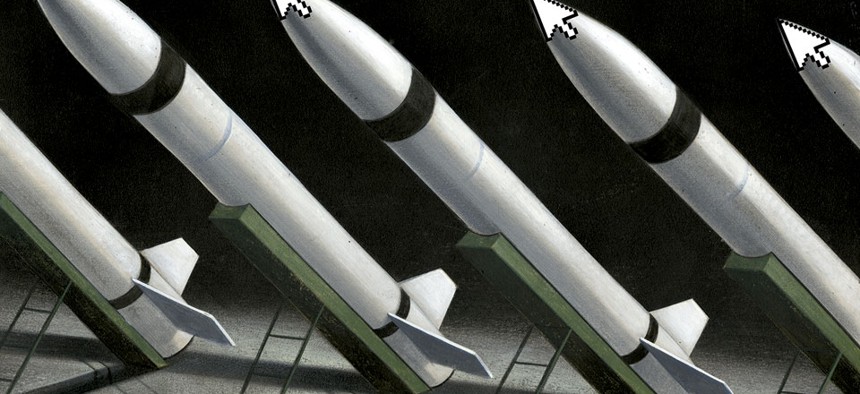
Jon Krause
Cyber Arms Control
Congress wants agencies to stop the proliferation of war worms, but lawmakers haven’t yet defined what those are.
Federal agencies during the next several months must work together on guidelines for controlling the trade of cyberwar technology. That requirement, made by Congress in late 2013, is sure to raise a host of legal, technical and operational challenges.
In programming, a cyber weapon often refers to malicious code that takes advantage of a software glitch called a “zero day,” to insert itself and manipulate data. For example, Stuxnet, an alleged U.S-Israeli cyber weapon, upended Iran’s nuclear program by exploiting a flaw in the country’s centrifuge systems.
The concern in Congress is that war worms, let loose in the black market, are being sold to the public and overseas aggressors.
The 2014 National Defense Authorization Act that lawmakers cleared in December 2013 requires federal departments, with input from industry, to devise “intelligence, law enforcement and financial sanctions” mechanisms to “suppress the trade in cyber tools and infrastructure that are or can be used for criminal, terrorist or military activities while preserving the ability of governments and the private sector to use such tools for legitimate purposes of self-defense.”
The law also directs the Obama administration to address the problem at the international level, an effort that began late last year. In December, the Financial Times reported that 41 nations, including the United States, Russia and Germany, were close to a deal that would equate sensitive cyber technologies to traditional arms under one of the world’s key agreements on weaponry export control. The revised terms for the Wassenaar Arrangement, as of January 2014, now include controls on “surveillance and law enforcement/intelligence gathering tools and Internet Protocol (IP) network surveillance systems or equipment,” which might damage international and regional security.
In a seemingly complementary maneuver, the U.S. defense authorization package calls on the administration to craft “principles for controlling the proliferation of cyber weapons that can lead to expanded cooperation and engagement with international partners.”
But Congress did not define what a cyber weapon is, making it hard to compare the two initiatives.
By fall, agencies must deliver recommendations for damping the proliferation of cyber weapons, including a draft statement of principles and a review of applicable legal authorities.
Some legal experts call the concept of cyber arms control impractical.
“In the physical world, the production of weaponry is restricted by the need for an industrial base. In cyberspace, weapons are bits and bytes and produced as intellectual property,” Paul Rosenzweig, a Homeland Security Department official during the George W. Bush administration, wrote on the Lawfare blog in July 2013. “With such an ease of manufacture (comparatively) and a global market, there seems to be precious little prospect for an arms-control type approach to eliminating the trade.”
Cyber weapon vendor and federal contractor Endgame Systems reportedly offers customers 25 zero-day exploits a year for $2.5 million.
Rosenzweig calls Congress’ proposal for cyber weapon nonproliferation “notably off target,” adding that “while the objective is certainly noble, I suspect the effort will be relatively unsuccessful.”
NEXT STORY: Tech Roundup







